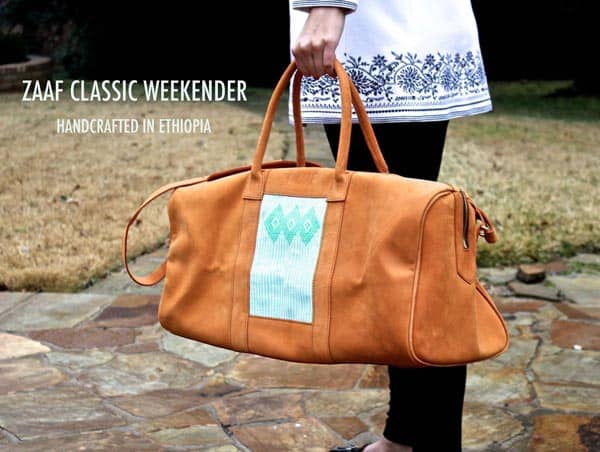Abai Schulze moved to to Addis Ababa in 2013 to start ZAAF – a company that specializes in handcrafted luxury leather handbags and accessories produced by Ethiopian artisans. The Ethiopian-American entrepreneur has been able to combine her background in economic development and love for fine arts and creativity into a successful brand. Through ZAAF, she seeks to create unique products, open up avenues of opportunity for talented local artisans, and promote brand Ethiopia.
Schulze graduated from George Washington University where she majored in Economics and minored in Fine Arts. At the core of her entrepreneurial journey, which she terms as an exciting adventure, is to be able to impact people on an individual level. She spoke to me about how she has been able to grow and market her brand.
Taking advantage of learning opportunities
Schulze, who was born in Ethiopia and adopted by an American family at age 11, remained connected to her culture. She travelled to Ethiopia during her summer breaks to do volunteer work. It was during one of these trips that she interned with USAID where she worked with artisans and designers, and helped them to create websites to market their products internationally.
This enabled her to see how businesses work in Ethiopia. Frequently visiting the country also gave her the opportunity to witness its economic transformation firsthand and ignited the desire to return in her.
Her senior thesis analyzed Ethiopia’s potential for exporting textile. “I wanted to go into that field but it didn’t make sense because the initial capital is huge and you have to have actual hands on experience,” Schulze said.
She later found out that Ethiopia has the finest leather in the world which it exports to European countries to be used as raw material by famous brands.
“I wanted to tap into that,” she said. “Why not make it at home, by our own people, add value to it, export it, and market and rebrand Ethiopia?” “That was my initial take on it,” she added.
 Schulze’s plan was to get some work experience in the US and go to business school before starting her own company. After graduation she interned at the Overseas Private Investment Corporation and later worked at Ashoka. It was while there that she met many entrepreneurs who inspired her to start her own company.
Schulze’s plan was to get some work experience in the US and go to business school before starting her own company. After graduation she interned at the Overseas Private Investment Corporation and later worked at Ashoka. It was while there that she met many entrepreneurs who inspired her to start her own company.
“I changed the timeline and decided to jump in,” she said. “I told myself, ‘If it fails, I am still young, I can start over.’” She then made the physical move to Ethiopia. “You can’t do this type of business from a distance,” she said. “I had to leave everything behind and focus on ZAAF.”
Branding and marketing ZAAF
In trying to figure out how to brand and market ZAAF, Schulze kept in mind the different connotations that come with products made in Africa. “A lot of it has that NGO feeling,” she said. “The language used is often, ‘It is made by poor people. Buy it otherwise they won’t have a job.”
She wanted to reject this guilt-driven purchase angle. “I wanted to show that we are talented, we just need to invest in our own people and we can produce something beautiful,” said Schulze. “You are buying the product because you like the product, not because you are feeling guilty.”
“Otherwise you are not going to have loyal customers who come back,” she added. “If they feel like they have done their good deed of the day, then they will move on to the next company.”

Schulze and her team were careful and deliberate about the language that they used in branding the company. Its products are made by talented Ethiopian artisans who went to school to sharpen their craft.
“They are not people who you just tell to piece two items together,” she said. Working with skilled artisans also ensures that the products are high quality. “We are trying to compete with international brands,” she said. “We want people to buy based on that.” The language they use to talk about the brand reflects all this.
“Our products stand out,” said Schulze. “When we produce them, we really want our customers to feel a sense of where the products are made.” ZAAF integrates ageless geometric patterns created on traditional looms with leather.
“Talented weavers meticulously count knots to produce patterns of fantastic combination of color and style,” she said. The unique aspects of the handbags and accessories has attracted media attention. “That organic attraction has helped us grow,” she added.
 Customer engagement is critical to the brand. They engage with customers primarily through social media. They are committed to providing excellent customer service. “If a customer is not happy with a product then we will redo it,” Schulze said. They also work to ensure that products are delivered in a timely fashion.
Customer engagement is critical to the brand. They engage with customers primarily through social media. They are committed to providing excellent customer service. “If a customer is not happy with a product then we will redo it,” Schulze said. They also work to ensure that products are delivered in a timely fashion.
Another way that Schulze keeps her customers happy is by investing in her team. She creates incentives for them based on their desires and needs. “That way they are loyal and create high quality products,” she said. “When you have a high turnover of employees, you can’t be consistent and your customers won’t be happy.”
Her advice to aspiring entrepreneurs:
Your initial purpose has to be strong. You have to be passionate about what you are creating because you will face a lot of challenges over time. This passion will help you find a way to solve them. Surround yourself with people who challenge you because sometimes you will be in your own bubble and you won’t know how far you are going.

Well done ABAI! Such a fan of her bags.
Fine girl no pimple!! Love what she’s doing ????